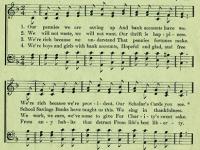Answer: Sara Louisa Oberholtzer
“We help ourselves, for we have learned
To save in little things.
We count our interest, for we know
The comfort money brings.”
So go the lyrics of “A School Savings Rally” written by Sara Louisa Oberholtzer, one of the most ardent apostles of school banking. Oberholtzer, a native of Chester County, Pennsylvania, was a journalist, poet, and anti-tobacco crusader who was introduced to the idea of school savings banks at an 1888 meeting of the American Economic Association. Oberholtzer was appointed national superintendent of the school savings bank division of the Women’s Christian Temperance Union (WCTU) in 1890. She viewed these banks as the best preventative against “waste, want, crime, intemperance, and general unrest.” Oberholtzer published countless pamphlets, distributing them by the tens of thousands, as well as a quarterly magazine, Thrift Tidings, which she edited from 1907 to 1923.
Oberholtzer carefully chronicled the movement’s growth, recording the number of student participants and the savings accumulated in dozens of communities. By the late 1920s, 15,000 schools had savings banks, where typically, each student would deposit a few pennies or more each week. The amount would be recorded on his or her bank card. By the eve of the Great Depression, more than four million American schoolchildren—or, approximately one in six K-12 students—had savings accounts in school-based banks.
A longer version of this article, written by Andrew L. Yarrow, was published in Pennsylvania Legacies.
Image: “A School Savings Rally” by Sara Louisa Oberholtzer

